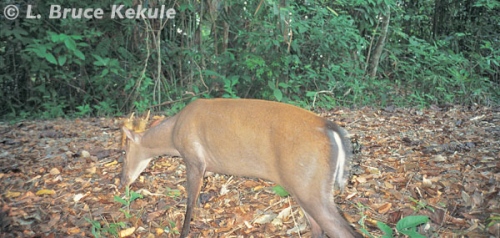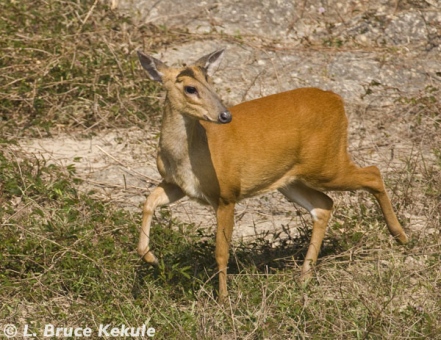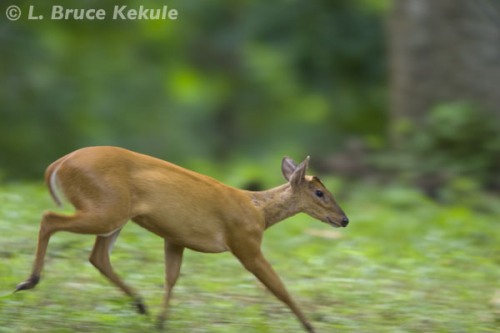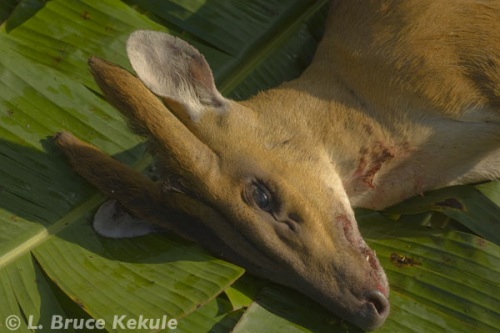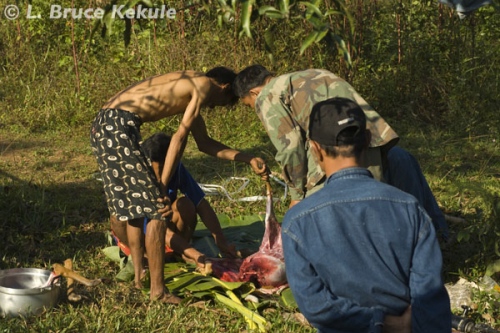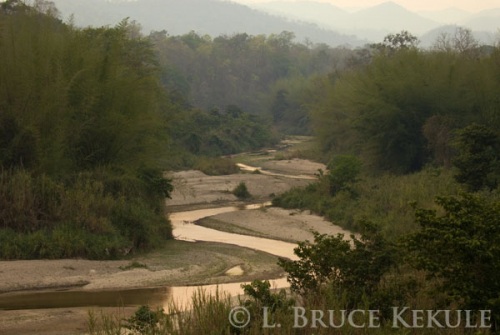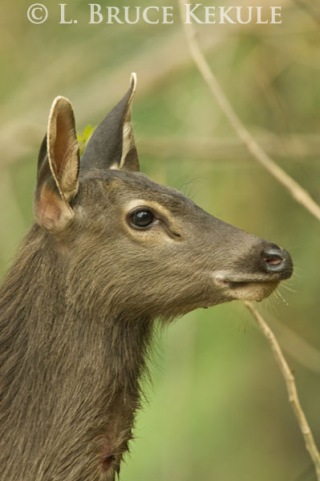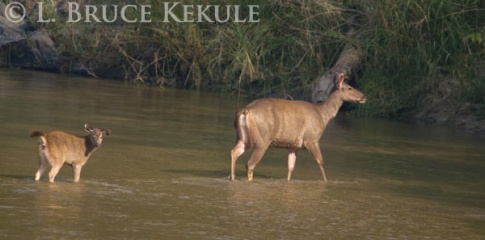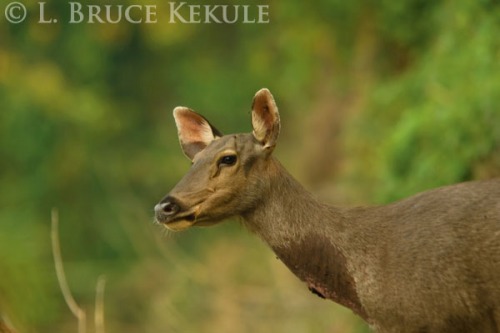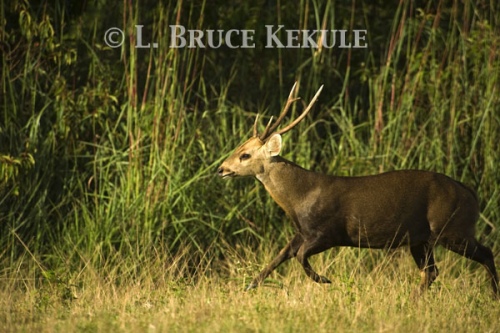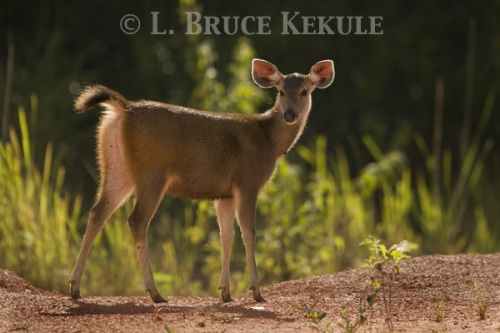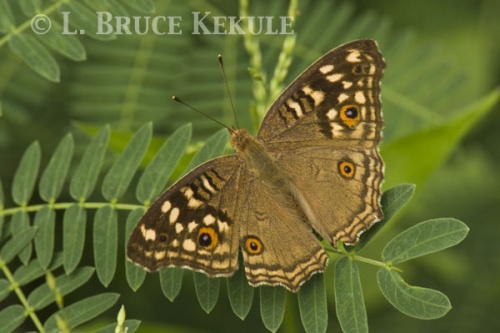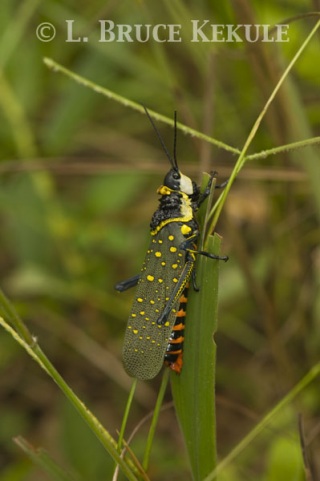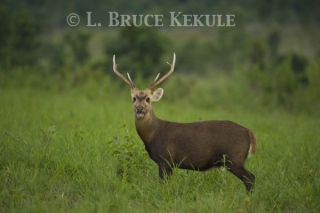Posts Tagged ‘deer’
Phu Khieo: Saving a species
Land of the plateau – pristine forest in the Northeast
Hog deer haven and introduction site
On Thai wildlife day, December 26, 1983, Her Majesty Queen Sirikit released four hog deer made up of two mature males and two females in breeding age at ‘Thung Kamang’ grassland in Phu Khieo Wildlife Sanctuary situated in the northeastern province of Chaiyaphum. This was the beginning of what is now a successful introduction program in order to save the species.
Hog Deer on the run in Phu Khieo Wildlife Santuary
The Crown Prince in 1987 introduced another four hog deer, and reintroduced several male and female sambar (Thailand’s largest deer) in the same area. In 1992, Her Majesty the Queen once again released more hog deer to boost the numbers of the herd. She also released three Eld’s deer (one male and two females). Unfortunately, this species has been difficult to monitor because of their preference for deep forest unlike the hog deer that prefer grassland and swampy habitat.
Phu Khieo massif
Over the years, the herd of hog deer has steadily increased due to a safe haven away from poachers and encroachment. In 2004, there were approximately 75 deer, and in May 2008, Kasetsart University conducted a survey around the grasslands and headquarters area counting more than 120 individuals. There are now approximately 140 hog deer in three or four separate herds. The sanctuary officials are constantly monitoring the herd with six hog deer fitted with radio collars and have established their range in the sanctuary.
It’s November and not a single cloud can be seen in the clear blue sky. Early morning air is crisp and cool. Heavy dew blankets Phu Khieo as mist rises from the forest. The sun arcs up into the sky and morning heat builds up. A mature sambar stag barks a warning call alerting all the animals within audible range that a predator is on the prowl. In the grasslands, a herd of hog deer grazing on tender young shoots is now on high alert. They are nervous and begin moving as the top carnivore of this forest stalks them.
Sambar yearling doe in late afternoon light
A pack of hungry Asian wild dogs working like a well-oiled machine concentrate on their target. They bump into the deer scattering them. The dogs go after an inexperienced doe and separate her from the herd. The chase is on. The deer becomes confused and makes a wrong turn. The dogs pull the struggling creature to the ground and go in for the kill. Within an hour the carcass is stripped and almost nothing is left except a few scraps. But it’s just another day in the balance of nature where natural selection and the struggle for life and death between predator and prey is played out.
In the early 1830s’ during the reign of King Mongkut, the French missionary Monsignor Jean-Baptiste Pallegoix, in his excellent book entitled ‘Description of the Kingdom of Siam’ published in 1850 reported seeing large herds of deer grazing on the central plains. Hog deer were still quite common in the Kingdom even at the turn of the 19th Century and could be found in all the river basins of the far North, the Northeast, the West and the whole of the Chao Phraya River basin and its tributaries. Hog deer fossils taken from sand dredging in many rivers dates back thousands of years to the Holocene, and teeth fossils of hog deer were discovered in a cave in Phu Khieo dating to the Pleistocene.
Hog deer buck and doe – the male has a radio collar
Unfortunately, these lowland deer were totally overcome by habitat destruction converting natural grasslands and swampy areas into agricultural land throughout the hog deer’s former range. Hunting deer was also a big business and warfare in Asia drove the skin trade. From the late Ayutthaya Period up to the early 20th Century, Siam exported millions of deer pelts from all the large species of deer including Schomburgk’s deer (extinct), sambar, Eld’s deer and hog deer to Japan. Deerskin being soft and supple was used to make leather for Samurai armor and clothing, boots and equipment mostly for the military. This was one of the main reasons for the disappearance of these remarkable creatures from the wild.
Short-nosed fruit bats
Captive breeding of hog deer, Eld’s deer, sambar and muntjac (barking deer) is carried out in some of the 22 wildlife breeding centers around the Kingdom set up by the Royal Forest Department, and now managed by the National Parks, Wildlife and Plant Conservation Department (DNP). The Phu Khieo Wildlife Breeding Center outside the sanctuary has been active since 1983 and is still breeding deer and wild pigs for future release into other wildlife sanctuaries and national parks.
Essarn is not all barren and dry like many people think. Over in the western part of the Northeast is Phu Khieo – Nam Nao Forest Complex that incorporates 19 protected areas, covering some 7,725 km2 (twelve national parks and seven wildlife sanctuaries) in the provinces of Chaiyaphum, Khon Kaen, Nong Bua Lum Phu, Udon Thani, Loei, Phechabun and Lop Buri. The complex incorporates a number of large forests on the Phetchabun and upper Dong Phayayen ranges. Phu Khieo, established in May 1972, is the largest sanctuary in the complex at 1,560 km2 made up of, a rocky plateau and steep mountains. The protected area is covered in forests of pine, deciduous, dry dipterocarp and evergreen with many streams that flow into the Chi, Lam Phrom and Sa Phung rivers.
Bird-eating spider
Phu Khieo has elephant, gaur, sambar, muntjac, mouse deer, tiger, clouded leopard, golden cat, back-striped weasel (extremely rare), black bear, gibbon, langur and macaque plus many other mammals can still found here. Jeffery McNeely found tracks in 1977 of the Sumatran rhinoceros on a mountain in the middle of the sanctuary. The last set of rhino footprints was recorded by the sanctuary staff some 10 years ago but has not been seen since. Crocodiles are thought to lurk in the backwaters but again, only footprints and feces have been discovered several years ago. These two species need further investigation and research to establish if they still exist, especially the rhino.
Rare birds such as the Oriental darter and white-winged duck live in the secluded wetlands found in this forest. Other birds include hornbill, osprey, black baza, blue pitta, Siamese Fireback, plus loads of babblers, flycatchers, barbets, kingfishers and other forest birds. The very rare purple cochoa has been sighted and photographed here.
Oriental Darter by the lake
Much research has been carried out by foreign and local researchers from various organizations. Stonybrook University in New York sent a team to monitor and record behavioral habits of the Phayre’s langur and crab-eating macaque. Lon Grassman, as a master student with Kasetsart University, did a camera-trap survey and, collared golden cat and clouded leopard plus other carnivores with support from Texas A&M University and he received his PhD from this excellent work. Kitti Kreetiyutanont who heads the Phu Khieo Research Station has done much research on biodiversity of flora and fauna found here, and in the buffer zone outside the sanctuary. He also has done some archaeology work finding pottery and tools thousands of years old. There are some cave drawings in the sanctuary indicating past civilizations. Wanchnok Suvarnakara, the deputy superintendant, is an avid wildlife photographer and has recorded many species on film and digital, and published a photographic book.
Pansi butterfly
For the first time in the history of wildlife sanctuaries since Salak Phra in Kanchanaburi was established in December 1965, a woman has been nominated as superintendant to Phu Khieo. Dr Kanjana Nitaya received a doctorate on management, and has run this protected area with determination to succeed. The staff and locals who have benefited from her management skills and leadership over the last four years respect her. In 2006, Phu Khieo was voted as the best wildlife sanctuary in all categories by DNP due to criteria established by the department. She is proud of this achievement and hopes this will help the conservation of this magnificent place well into the future.
Bombay locust
However, poaching and encroachment is still an on-going problem for the staff. Another serious long-term idea from politicians in the lowlands is to build a dam across the Sa Pung Nua River on the southern face of the plateau not far from Nong Bua Daeng in Chaiyaphum. If this dam were to become a reality, a large swath of forest would be inundated and damage the ecosystem already in jeopardy. All efforts should be made to stop this project before it goes too far. As Thailand’s best wildlife sanctuary, it should not be compromised by the construction of a man-made scheme.
Saving a species from extinction should be a top priority of the DNP. Other ungulates like goral, serow and banteng should be reintroduced into protected areas where they once thrived. Some may argue against introduction or reintroduction, but as we loose more and more species, release is a practical way to save Thailand’s rare animals from extinction in the wild. It is up to the department to instigate and increase these introduction/reintroduction projects, and then to protect these animals from danger by all means available. Budgets for enforcement and protection need to increase, and more staff to man any project to save a species from extinction is an utmost priority.
Hog deer buck in the grassland
Historically, the range of the hog deer spread from India and Nepal, east through Burma and Thailand, to Laos, Cambodia and Vietnam. This deer is now restricted to just fragments of its former range. In Thailand, the last sighting of hog deer was in Nong Khai province in the Northeast sometime during November 1963. There are some hog deer herds in the wilds of Cambodia and Laos.
Hog deer were typically found on alluvial plains and lowland forest along rivers, particularly near marshes with tall grass. Today it would be impossible to reintroduce these deer into any of their former habitat, but a few protected areas like Phu Khieo are ideal. Any introduced or reintroduced species needs the full protection afforded by a national park, wildlife sanctuary or non-hunting area.
Hog deer are medium-sized animals that resemble the larger and more common sambar deer in appearance. Male hog deer antlers are similar in shape as sambar but smaller. Depending on the season, they have grayish to dark brown fur. Females like all other deer species, have no antlers. Fawns have spotted coats. Spots can also be clearly seen on some adults.
These deer are more of a grazer than a browser and feeds on grass. They are gregarious, forming large family groups. The rut starts in September and goes on through October. A single fawn is born eight months later, during the rainy season around July or August. Hog deer received their name because of the way they move. Unlike other deer, they seldom jump over a bush or high grass, but they tend to run through the underbrush with head held low to the ground, much like a hog.



